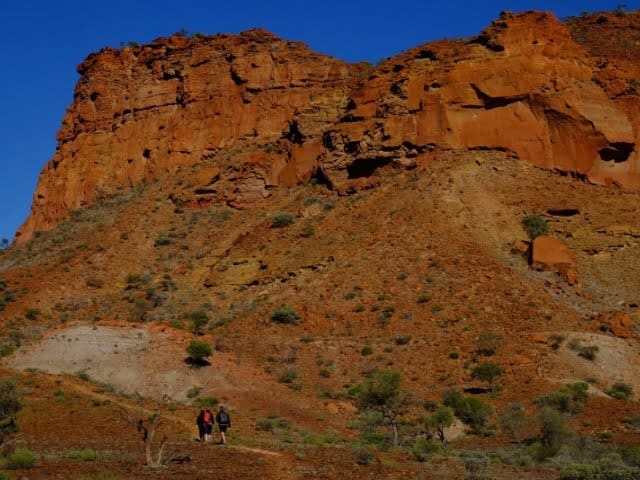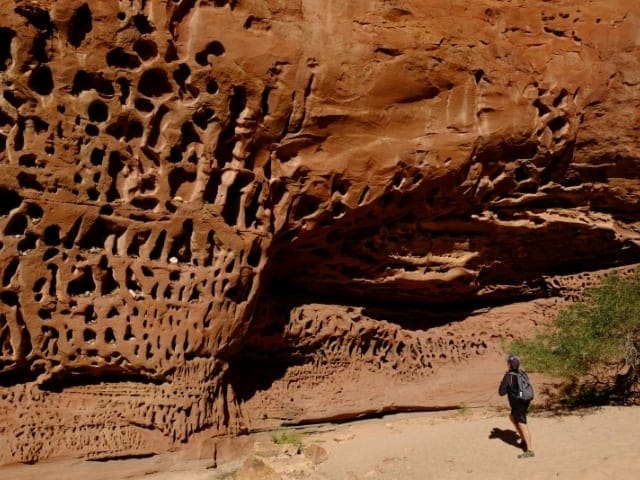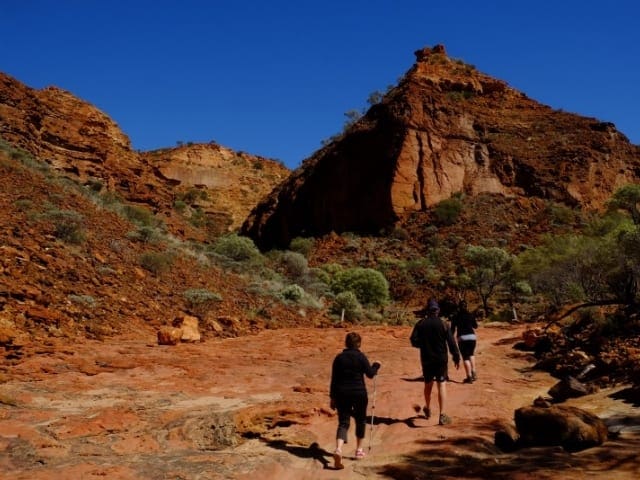The Mandu Mandu walk is an excellent three kilometre loop trail that leads along the gorge rim then descends into the gorge. It is steep in sections so a reasonable degree of fitness is required. Go early in theday when it's cooler and you'll have good chance of spotting some rock wallabies.
By far most visitors to Exmouth focus their attention on the incredible marine environment of Ningaloo Reef. There are however some landbased attractions worth looking at. One of these attractions is a great walk that goes up Mandu Mandu Gorge deep into Cape Range National Park. The walk trail begins 14 kilometres south of Milyering Discovery Centre on the Yardie Creek Road. From the Car Park, the trail enters the dry creek bed of loose water-smoothed rocks. On both sides sheer vibrant red cliffs rise dramatically. The trail has markers along the way as the route is not easily descernable with all those rocks. Look carefully and you may see rare rock wallabies in shady areas of the gorge walls. After a while the trail rises steeply out of the gorge onto the plateau where numerous flowering plants can be seen. Its a bit of a haRoad slog, but don't think the worse is over just because you made it to the top. There are several steep ups and downs to negotiate before getting back to the Car Park. It is highly recommended that this walk be done early in the day as it is often extremely hot.
Got some great shots from this hike? Upload your photos here to inspire others and show off the beauty of the trail!
Submitting your photos doesn’t mean you lose ownership. You can be credited for your contributions, and you can request removal at any time.
Please don’t copy GPX files or content from this site to AllTrails or other platforms. Each trail has been personally mapped, documented, and refined to support Australia’s bushwalking and hiking community. While some details come from land managers, every listing reflects significant personal effort. This is a free, community-driven initiative—your respect helps keep it that way.
Total distance: 3021 m
Max elevation: 95 m
Min elevation: 10 m
Total climbing: 245 m
Total descent: -242 m
Getting there
Getting to the trailhead: Cape Range National Park.
Closest towns to this walk: Carnarvon, Coral Bay, Denham, Exmouth, Karratha, Onslow, Onslow Carnarvon
About the region
Located adjacent to Ningaloo Marine Park, Cape Range National Park boasts spectacular rocky gorges carved by ancient rivers that adjoin one of the most pristine and beautiful coastlines in the world. A highlight to any Cape Range experience is a trip to Yardie Creek, which flows between sheer cliffs. Guided boat tours are available for visitors to enjoy the tranquillity of the gorge and view the wildlife in its natural setting.
Similar walks nearby
Looking for more walks in or near Cape Range National Park? Try these trails with a similar difficulty grade.
Favourite

Favourite

Kennedy Range National Park
Favourite

Kennedy Range National Park
Favourite

Kennedy Range National Park
Track grade
Grade 3 (Moderate) - Walks for Most Fitness Levels: Grade 3 on the
AWTGS represents moderate walking tracks. These are ideal for walkers with some fitness who are comfortable with some hills and uneven terrain. While suitable for most ages, some bushwalking experience is recommended to ensure a safe and enjoyable experience. Tracks may have short, steep hill sections, a rough surface, and many steps. The total distance of a Grade 3 walk can be up to 20 kilometers.
Explore safe
Plan ahead and hike safely! Carry enough water, pack layers for changing conditions, and bring safety gear like a torch, PLB, and reliable communication device. Check official sources for trail updates, closures, and access requirements, and review local weather and bushfire advice. Most importantly, share your plans with someone before you go. Being prepared makes for a safer and more enjoyable hike! Stay Safe, Explore More, and Always #ExploreSafe.
Packing checklists
What you carry in your pack depends on factors like weather, terrain, and your adventure type. Not sure what to bring? My free planning, food, and packing checklists are a great starting point, covering day hikes, overnight trips, and multi-day adventures. Use them to customise your kit and always prioritise safety.
Let someone know
Before heading out, take a moment to fill out your trip intentions form. It’s a quick way to share your hike details with family or friends. If something goes wrong, they can notify emergency services, ensuring a faster response and peace of mind. Stay safe and enjoy your adventure
Suggest an edit
Spotted a change on this trail? Maybe there are new features, the route has shifted, or the trail is permanently closed. Whatever the update, I’d love your input. Your feedback helps fellow hikers stay informed and ensures that our trail info stays fresh and reliable.






